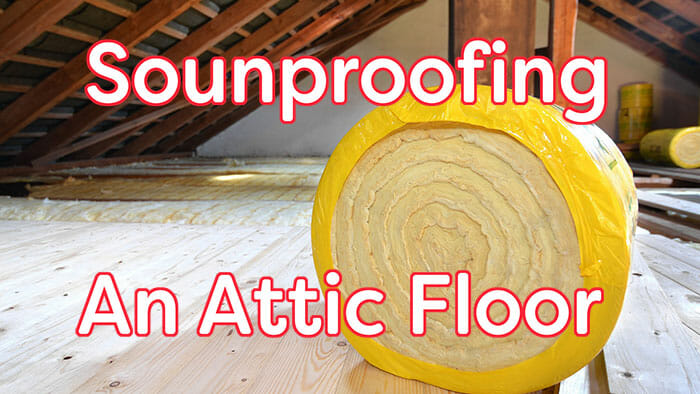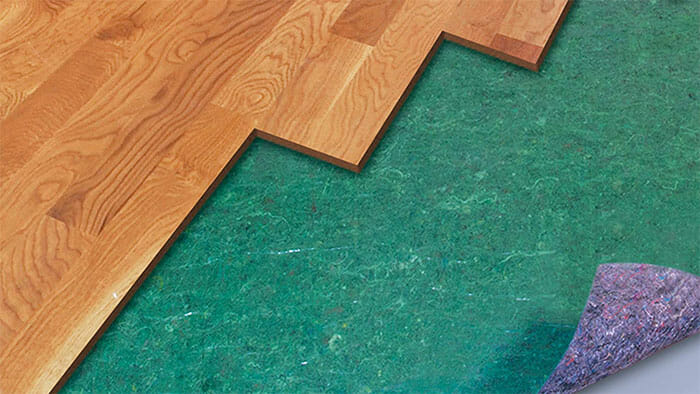While soundproofing an attic floor may seem like a complex and time-consuming process, it’s really not as difficult as you might imagine.

How to soundproof an attic floor?
The best way to soundproofing an attic floor is blocking both acoustic and vibrational impact noises.
While acoustic sounds (like talking, music, echoes, etc.) can easily be blocked by adding dense materials such as mineral wool between joists, impact noises (footsteps, bass tones, dropping things) will require you to install an impact absorption barrier between the source of the sound and the underside of the floor.
Below, I will go over how to effectively and efficiently soundproof your attic floor to keep loud footsteps and other noises that carry from bothering anyone hanging out on the lower levels of your home.
Soundproofing Materials To Consider for Attic Floors
Laminate Flooring Underlayment
I’m going to assume that if you want to soundproof your attic, you’re trying to block out the sounds of people walking, talking, and generally moving around up there.
This thick felt can help you accomplish that without having to do a ton of construction or build on an additional subfloor for your attic.
It goes underneath essentially any kind of engineered flooring and creates a barrier between the top part of the floor and the joists underneath.
I recommend the Roberts 70-193 Wood and Laminate Flooring Underlayment.

The felt has an STC (sound transmission) rating of 66 which means that it can block acoustic noises such as talking or other airwave sounds. Most soundproofing materials will do this though.
So what’s so great about this cushion roll?
Well, it also has an impact sound rating (IIC) of 67.
This means that it can absorb sounds like footsteps and other vibrational noises, which are usually the noises that travel the most to the rooms underneath your attic.
If you have any kind of engineered flooring like wood or laminate in your attic, this is an amazing solution to consider. It’s fast, easy, and effective.
Cheaper alternative: Quietwalk underlayment
If you’re in an area where humidity is a factor, you may want to consider the Quietwalk sound reduction underlayment.
It offers firm support and acoustic absorption for a safer, more energy efficient attic.
It’s ideal for absorbing acoustic sound and is less expensive than many other options. It’s also easy to install and comes with comprehensive instructions and buyer information.
This is a great option for anyone with:
– Laminate Floors
– Floating Engineered Wood
– Floating Engineered/Rigid Core Vinyl Plank (EVP) – 5mm and thicker
– Floating Wood/Composite (WPC) – 5mm and thicker
– Floating Luxury Vinyl Plank (WPC) – 5mm and thicker
However, if you really want to reduce the sounds coming from footsteps on hardwood floors, you’ll want to use this material in combination with other methods like a subfloor or floating joists.
• Easy to install and cut
• Approved for in-floor radiant heat systems
• Absorbs acoustic sounds well and reduces some vibration and impact noise
• Compression resistant
• Moisture protection and insulation
Most Effective Attic Floor Soundproofing Methods
You can soundproof your attic in three main ways: limit the impact between flooring and joists, build an air cavity by installing a subfloor, or use soft impact absorbing materials with acoustic absorption properties on the attic floor itself.
If you want a super quiet space with total noise isolation, you may want to use a combination of all three of these methods.
Soundproofing Basics
When you’re soundproofing your attic, there are a few factors that you have to keep in mind.
You’ll want to reduce vibrational impact noises and acoustic sound waves while still allowing for ventilation and air flow.
This is a tough nut to crack but once you know how to do it, the actual installation process is pretty easy.
1. Joist Impact Reduction
This simply means putting a barrier in place between the underside of your flooring materials and your joists.
You’ll want to create a gap between the joists and the flooring that will absorb the impact of any movements taking place in your attic. Floor floaters are a great way to accomplish this.
2. Install a Subfloor
Installing a subfloor is the most time consuming and expensive way to soundproof your attic.
However, it’s also the most effective option.
Subfloors create a gap between the joists and the floor that people will be walking on or moving objects around on.
A subfloor can also make you attic more energy efficient. You can use green glue or any other flexible polyurethane bonding adhesive to help to ensure that your subfloor reduces noise and impact sounds as much as possible.
Installing a subfloor is one of the best ways to ensure that your attic is a quiet area with a minimum amount of sound transference.
However, it can also be one of the most time consuming and expensive options. A subfloor goes below the floor to create an additional air and sound barrier.
To save time, you may want to use some kind of install-ready pre-insulated subfloor material like these Amdry panels.
These panels are probably the best pre-made subfloor panels available commercially.
They come pre-cut and ready to install. You just have to build the structure above your joist and they’re ready to go. they absorb a lot more sound than plywood and help to keep your attic energy efficient and dry.
They’re designed to combine deep drainage and ventilation channels which allow moisture and air to move freely.
This is ideal for promoting surface drying and reducing the potential for mold, mildew, and odors.
In at attic where people are going to be spending time, these properties can be important.
• Better for insulation and soundproofing than plain plywood
• Amdry patented system for quick & easy installation
• Can be used for various applications, including attics
• Allow moisture and air to move freely reducing damage from humidity
3. Use Sound Reduction Flooring Materials
This is another great way to help absorb impact noises in your attic. If you have a carpeted attic, you can use a thick carpet padding to help reduce impact and acoustic sound.
If you’re using laminate or hardwood flooring, you’ll need floor underlayment materials of some kind.
I listed a few great options above. Any underlayment should have sound absorption acoustic blocking properties as well as impact and vibrational reduction.
The Ultimate Combination Method
The absolute best way to effectively soundproof your attic floor involves combining all three of these methods. to do this, you’ll install a subfloor, use floaters to reduce impact between your joists and your floor, adhere your subfloor panels to to your subfloor joists with a polyurethane absorbing adhesive glue, and then cover the floor with either thick and springy carpeting and a carpet pad or laminate flooring with a sound blocking and impact reducing underlay.
As an extra measure, I recommend insulating with mineral wool and fiberglass if it is allowed by the building codes in your area.
Your fiberglass insulation (if you already have some in place) can be left alone. Under your subfloor, add mineral wool insulation as an extra precaution.
This will give you the quietest floor imaginable and make your attic one of the
Also, you’ll need to…
• Think About Your Material Options
There are a variety of soundproofing materials out there. The most popular soundproofing materials are polyurethane, mineral wool, foam, rubber, carpet or fabric materials, thick multi-cork tiles, cellulose fiber, and other synthetic mineral fiber combinations.
• Have a Budget in Mind
Have a clear budget in mind before starting your job and try to stick to it. While I try to be an optimist in my daily life, when it comes to budgeting I like to think in a “worst case scenario” mindset.
In my experience, it’s better to find out I have actually managed to save a little bit of money than to get stuck halfway through a project trying to regroup and accumulate missing funds.
• Measure Twice, Cut Once
Whenever I do a job, I try to measure twice and cut once. When taking the measurements of your attic, keep in mind that some subfloor insulation materials may have to be applied in more than one layer.
If this is the case, you might want to consider doubling up on materials. Thicker materials will block louder noises more easily.
A thicker material may be a good option for attics with wood floors or in older homes.
Since for some structures, this isn’t an option, you can always use more than one layer of a lighter material.
Either way, make sure that you have measured square footage properly and have a general idea of how much soundproofing material you’re going to need before beginning a job.
Conclusion
These are my tips on soundproofing your attic floor effectively. Remember, what works for one attic may not work for another.
Your options may also be limited by your area’s building codes and material limitations.
What do you think? Did I leave out any important basic information? What methods have you found to be helpful in your attic soundproofing experience? Please feel free to comment, share, and leave your feedback!

Hi Jim. I liked your information.Just wondering where I could source this material and what is the cost per a square metre? I live in Ireland. Thanks